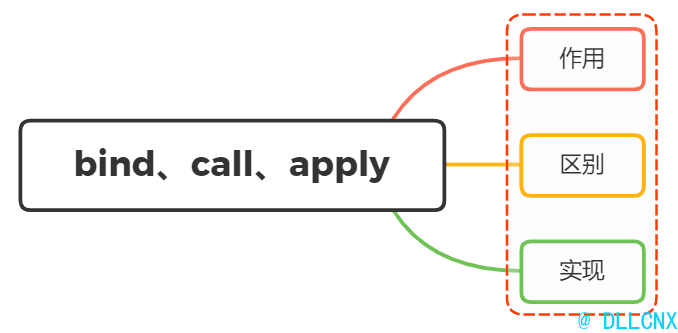bind、call、apply 区别?如何实现一个 bind?
简版
共同点
- 可以修改函数 this 指向
区别
第一个是传参方式不同: call 和 bind 是列表传参,apply 是数组或伪数组传参
第二个是执行机制不同:call 和 apply 是立即执行,bind 不会立即执行而是生成一个修改 this 之后的新函数
一、作用

call、apply、bind作用是改变函数执行时的上下文,简而言之就是改变函数运行时的this指向
那么什么情况下需要改变this的指向呢?下面举个例子
const name = 'lucy'
const obj = {
name: 'martin',
say: function () {
console.log(this.name)
},
}
obj.say() //martin,this指向obj对象
setTimeout(obj.say, 0) //lucy,this指向window对象从上面可以看到,正常情况say方法输出martin
但是我们把say放在setTimeout方法中,在定时器中是作为回调函数来执行的,因此回到主栈执行时是在全局执行上下文的环境中执行的,这时候this指向window,所以输出lucy
我们实际需要的是this指向obj对象,这时候就需要该改变this指向了
setTimeout(obj.say.bind(obj), 0) //martin,this指向obj对象二、区别
下面再来看看apply、call、bind的使用
apply
apply接受两个参数,第一个参数是this的指向,第二个参数是函数接受的参数,以数组的形式传入
改变this指向后原函数会立即执行,且此方法只是临时改变this指向一次
function fn(...args) {
console.log(this, args)
}
let obj = {
myname: '张三',
}
fn.apply(obj, [1, 2]) // this会变成传入的obj,传入的参数必须是一个数组;
fn(1, 2) // this指向window当第一个参数为null、undefined的时候,默认指向window(在浏览器中)
fn.apply(null, [1, 2]) // this指向window
fn.apply(undefined, [1, 2]) // this指向windowcall
call方法的第一个参数也是this的指向,后面传入的是一个参数列表
跟apply一样,改变this指向后原函数会立即执行,且此方法只是临时改变this指向一次
function fn(...args) {
console.log(this, args)
}
let obj = {
myname: '张三',
}
fn.call(obj, 1, 2) // this会变成传入的obj,传入的参数必须是一个数组;
fn(1, 2) // this指向window同样的,当第一个参数为null、undefined的时候,默认指向window(在浏览器中)
fn.call(null, [1, 2]) // this指向window
fn.call(undefined, [1, 2]) // this指向windowbind
bind 方法和 call 很相似,第一参数也是this的指向,后面传入的也是一个参数列表(但是这个参数列表可以分多次传入)
改变this指向后不会立即执行,而是返回一个永久改变this指向的函数
function fn(...args) {
console.log(this, args)
}
let obj = {
myname: '张三',
}
const bindFn = fn.bind(obj) // this 也会变成传入的obj ,bind不是立即执行需要执行一次
bindFn(1, 2) // this指向obj
fn(1, 2) // this指向window小结
从上面可以看到,apply、call、bind三者的区别在于:
- 三者都可以改变函数的
this对象指向 - 三者第一个参数都是
this要指向的对象,如果如果没有这个参数或参数为undefined或null,则默认指向全局window - 三者都可以传参,但是
apply是数组,而call是参数列表,且apply和call是一次性传入参数,而bind可以分为多次传入 bind是返回绑定 this 之后的函数,apply、call则是立即执行
三、实现
实现bind的步骤,我们可以分解成为三部分:
- 修改
this指向 - 动态传递参数
// 方式一:只在bind中传递函数参数
fn.bind(obj, 1, 2)()
// 方式二:在bind中传递函数参数,也在返回函数中传递参数
fn.bind(obj, 1)(2)- 兼容
new关键字
整体实现代码如下:
Function.prototype.myBind = function (context) {
// 判断调用对象是否为函数
if (typeof this !== 'function') {
throw new TypeError('Error')
}
// 获取参数
const args = [...arguments].slice(1),
fn = this
return function Fn() {
// 根据调用方式,传入不同绑定值
return fn.apply(this instanceof Fn ? new fn(...arguments) : context, args.concat(...arguments))
}
}